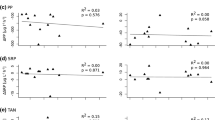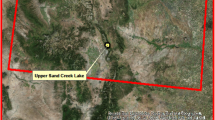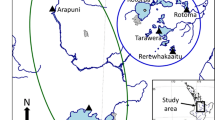Abstract
The influence of certain environmental factors on the flux of selenium through marine biota has been studied, using Mytilus galloprovincialis and Lysmata seticaudata as test organisms of commercial interest. Over a selenium concentration range in sea water spanning 3 orders of magnitude, bioaccumulation of selenium by mussels was strongly dependent upon the ambient selenium concentration in sea water. Mussels accumulated Se (+4) to a much greater extent than Se (+6) and bioaccumulation was dependent upon temperature and mussel size. The presence of varying amounts of mercury did not significantly alter selenium uptake kinetics in mussels. Shrimp accumulated selenium to a lesser degree than mussels, the difference in concentration factors being due to the large amount of sorbed isotope lost with shrimp molts. Once incorporated, selenium was lost more rapidly from shrimp than from mussels. Temperature influenced selenium loss from mussels but did not alter the elimination rate in shrimp. Neither the chemical form of selenium nor mercury concentration in the organism affected loss of selenium from mussels. Elimination of selenium from shrimp was dependent upon the route of uptake; more rapid loss was noted from individuals which had absorbed the isotope directly from water than from those which had accumulated selenium via the food chain. In general, long-term selenium turnover rates were quite similar for both species; biological half-times ranged from 58 to 60 days for shrimp and 63 to 81 days for mussels. In the case of mussels, turnover rates measured in animals maintained in the laboratory differed somewhat from those determined from individuals held in field enclosures. Observed variations in flux rate may have been due to differences in food availability in the two experimental systems.
Similar content being viewed by others

Literature Cited
Anonymous: Baseline studies of pollutants in the marine environment and research recommendations, 54 pp. The IDOE Baseline Conference, May 24–26, 1972, New York 1972
Anonymous: Review of harmful substances. In: Joint Group of Experts on the Scientific Aspects of Marine Pollution (GESAMP) — Supplement to the Report of the Sixth Session, GESAMP VI/10/Suppl. 1, 26 pp., Geneva: World Health Organization 1974
Bertine, K.K. and E.D. Goldberg: Fossil fuel combustion and the major sedimentary cycle. Science, N.Y. 173, 233–235 (1971)
—: Trace elements in clams, mussels and shrimp. Limnol. Oceanogr. 17, 877–884 (1972)
Blaylock, B.G., E.H. Curtiss, R.A. Goldstein, J.W. Huckabee, C.S. Matti, S.L. Perryman and J.P. Witherspoon: Ecology of toxic metals. In: Ecology and analysis of trace contaminants, Prog. Rep. 1973, pp 140–175, Oak Ridge National Laboratory: USAEC 1974
Boyden, C.R.: Trace element content and body size in molluscs. Nature, Lond., 251, 311–314 (1974)
Chau, Y.K. and J.P. Riley: The determination of selenium in sea water, silicates and marine organisms. Analytica chim. Acta 33, 36–49 (1965)
Fowler, S.W. and G. Benayoun: Experimental studies on cadmium flux through marine biota. In: Comparative studies of food and environmental contamination, pp 159–178. Vienna: International Atomic Energy Agency 1974
Fowler, S.W. and G. Benayoun: Accumulation and distribution of selenium in mussel and shrimp tissues. Bull. envir. Contam. Toxicol. (In press)
Ganther, H.E.: Selenium: the biological effects of a highly active trace substance. In: Trace substances in environmental health — IV, pp 211–221. Ed. by D. Hemphill, Columbia: University of Missouri 1970
—, C. Goudie, M.L. Sunde, M.J. Kopecky, P. Wagner, Sang-Hwan Oh and W.G. Hoekstra: Selenium: relation to decreased toxicity of methylmercury added to diets containing tuna. Science, N.Y. 175, 1122–1124 (1972)
Gissel-Nielsen, G. and M. Gissel-Nielsen: Ecological effects of selenium application to field crops. Ambio 2, 114–117 (1973)
Goldberg, E.D., W.S. Broecker, M.G. Gross and K.K. Turekian: Marine chemistry. In: Radioactivity in the marine environment, pp 137–146. Washington, D.C.: National Academy of Sciences 1971
Ketchum, B.H.: Biological implications of global marine pollution. In: The changing global environment, Ed. by S.F. Singer. pp 311–328. Dordrecht, Holland: D. Reidel Co. 1975
Koeman, J.H., W.H.M. Peeters, C.H.M. Koudstaal-Hol, P.S. Tjioe and J.J.M. De Goeij. Mercury-selenium correlations in marine mammals. Nature, Lond. 245, 385–386 (1973)
Mackay, N.J., M.N. Kazacos, R.J. Williams and M.I. Leedow: Selenium and heavy metals in black marlin. Mar. Pollut. Bull. 6, 57–61 (1975)
Miettinen, J.K., M. Heyraud and S. Kečkeš: Mercury as a hydrospheric pollutant. II. Biological half-time of methylmercury in four Mediterranean species: a fish, a crab and two molluscs. In: Marine pollution and sea life, pp 295–298. Ed. by M. Ruivo (F.A.O.). London: Fishing News (Books) Ltd. 1972
Robertson, D.E., L.A. Rancitelli, J.C. Langford and R.W. Perkins: Battelle-Northwest contribution to the IDOE baseline study. In: Baseline studies of pollutants in the marine environment, pp 231–273. Background papers for a workshop sponsored by the National Science Foundation's IDOE, Brookhaven National Laboratory, 24–26 May, 1972
Sandholm, M., H.E. Oksanen and L. Pesonen: Uptake of selenium by aquatic organisms. Limnol. Oceanogr. 18, 496–499 (1973)
Shrift, A.: A selenium cycle in nature? Nature, Lond. 201, 1304–1305 (1964)
Stoewsand, G.S., C.A. Bache and D.J. Lisk: Dietary selenium protection of methylmercury intoxication of Japanese quail. Bull. envir. Contam. Toxicol. 11, 152–156 (1974)
Van Weers, A.W.: Uptake and loss of 65Zn and 60Co by the mussel Mytilus edulis. In: Radioactive contamination of the marine environment, pp 385–401. Vienna: International Atomic Energy Agency 1973
Young, D.R. and T.R. Folsom: Loss of 65Zn from the California sea mussel Mytilus californianus. Biol. Bull. mar. biol. Lab., Woods Hole 133, 438–447 (1967)
Author information
Authors and Affiliations
Additional information
Communicated by J.M. Pérès, Marseille
Based on a communication given at the International Symposium on Interaction Between Water and Living Matter, Odessa, USSR, 6–10 October, 1975.
Rights and permissions
About this article
Cite this article
Fowler, S.W., Benayoun, G. Influence of environmental factors on selenium flux in two marine invertebrates. Mar. Biol. 37, 59–68 (1976). https://doi.org/10.1007/BF00386779
Accepted:
Issue Date:
DOI: https://doi.org/10.1007/BF00386779



